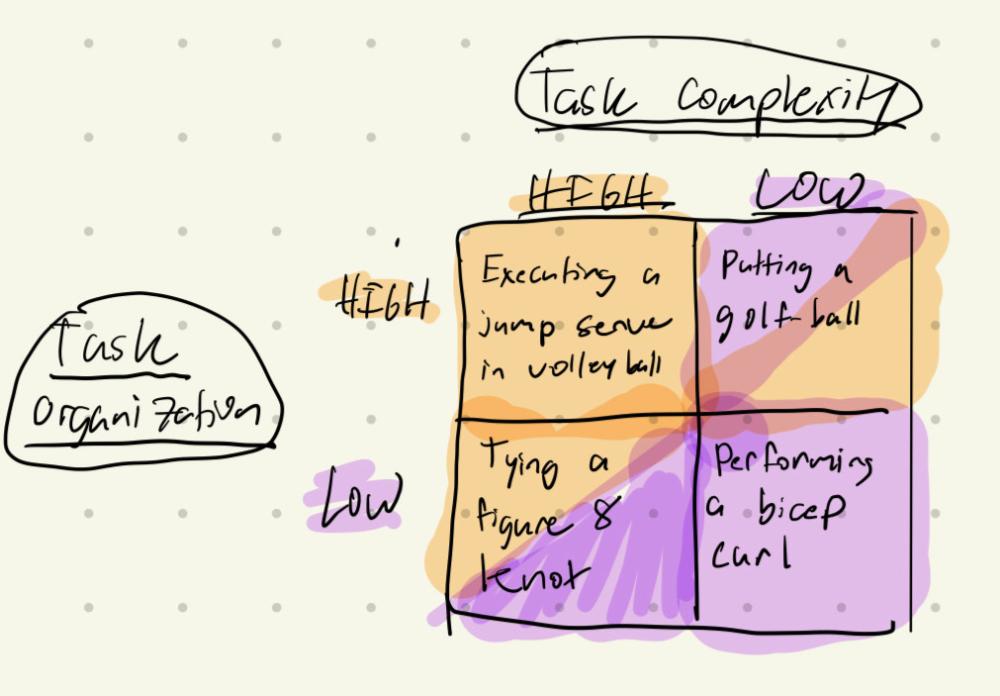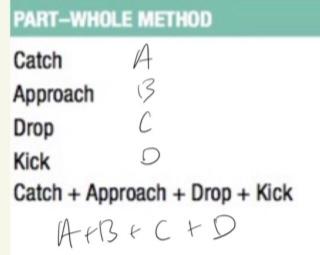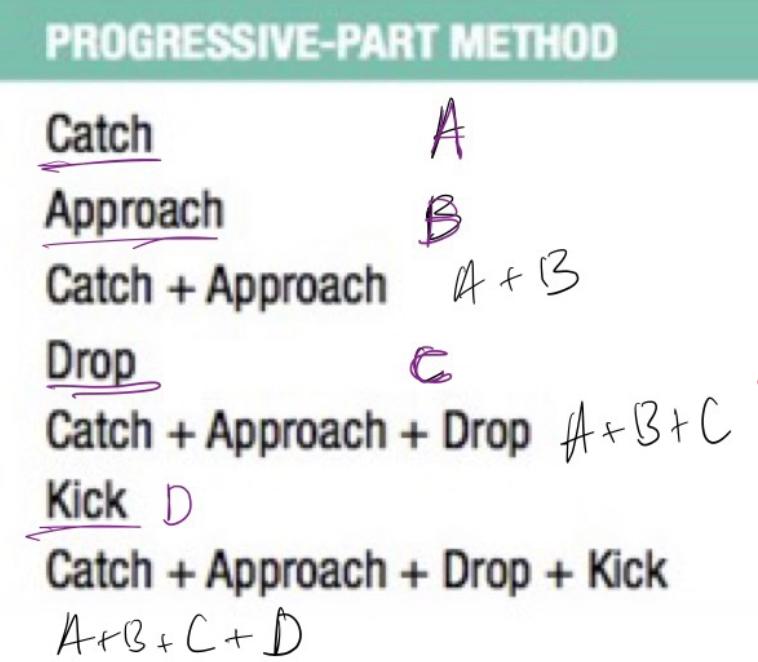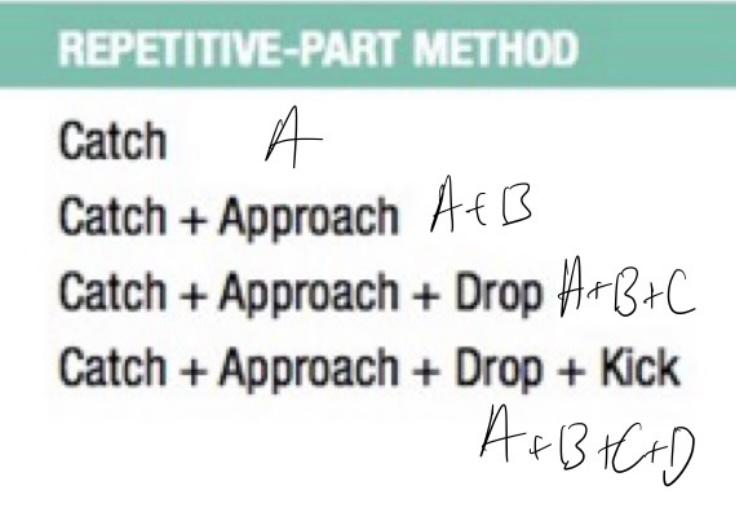“Practice makes perfect...”
Consider the influence (x3)
- Learner
- Task
- Environment
“Practice makes perfect...”
- In reality, practice does not guarantee that a learner will become more proficient
- Careful practice design => gains in skill proficiency
Breaking Down Skills
-
When should...
- skill be broken into parts?
- be practiced as a whole?
-
How do/can
- speed and accuracy influence skill acquisition?
- one best learn skills that must be performed equally
well on both the
dominant and non-dominant sides?
Whole vs. Part Practice
• Part
practice method
- Simplifies the skill
- Allows for
early success,
- leading to increased motivation
- Allows practice on problematic components
- ignores already mastered ones
Whole vs. Part Practice
• Whole
practice method can be favored
- Depends on which will result in the greatest amount of positive transfer
Whole vs. Part Practice
Items to consider:
- Nature of the skill
- Capability of the learner
- Part practice techniques
- Attention cueing
1st thing to consider: Nature of the Skill
Task complexity
-
How many...
- subcomponents?
- information processing demands?
1st thing to consider: Nature of the Skill
Task organization
-
How much does
- the performance of each
part, depend on the component that
before/precedes it?
- the performance of each
part, depend on the component that
Classifying Skills According to Complexity and Organization

Whole practice
- HIGH = organization,
- LOW = complexity
Part practice
- LOW = organization,
- HIGH = complexity
Whole vs. Part Practice:
Capability of learner
-
Part practice: LOW/LIMITED movement experiences:
- Promotes success, develops good habits
- Whole practice: HIGH motivation with experience
Whole vs. Part Practice:
Part practice techniques
-
Always teach how parts are associated with the
whole skill
- promotes transfer to the whole skill
Part Practice Techniques
3 types:
- Segmentation
- Fractionization
- Simplification
Segmentation
-
Skill is separated into parts
- based on spatial or temporal elements
- Part-whole method • Progressive-part method • Repetitive-part method
Segmentation
• Part-whole method
- Performing each part separately
Segmentation
• Progressive-part method
-
Practice two parts separately,
- then combine both parts together
Segmentation
• Repetitive-part method
-
Similar to progressive-part,
- except learner does not practice new parts independently
Implementation of Part Practice Sequences in Punting
Part-Whole method

Implementation of Part Practice Sequences in Punting
Progressive-Part method

Implementation of Part Practice Sequences in Punting
Repetitive-Part Method

Implementation of Part Practice Sequences in Punting
Foward+backward chain

Fractionization
• Skill components normally
performed
simultaneously are practiced independently
•
Effectiveness is questionable
– Rhythmic skills requiring
bimanual coordination,
upper- and lower-limb coordination
–
Fractionization should NOT be used due to high
organization of
skills
• CAN be used when spatial or temporal
movements are
different for each limb
-
Skill components normally performed
simultaneously
- are practiced independently
-
CAN be used
- when spatial or temporal movements are different (for each limb)
Fractionization
• Effectiveness is questionable
-
Rhythmic skills requiring bimanual coordination,
- upper- and lower-limb coordination
- Should NOT be used
- due to high organization of skills
Simplification
- Reduce the level of difficulty of the task (or some aspect of it):
- Change complexity of environment
- Use skill-building activities and lead-up games
- Sequence from simple to complex
Simplification
• Modify the equipment
– Size, length, weight, grip, rigidity
Simplification
• Reduce coordination requirement
– Reduce movement requirements
– Change balance, force, speed, accuracy
Speed-Accuracy Tradeoff
• Governs spatial accuracy, not temporal
- Increasing speed CAN decrease timing errors
- Emphasize speed with temporal skills, accuracy with spatial skills?
Speed-Accuracy Tradeoff
• Limitations
-
Most complex motor skills
- involve both spatial and temporal accuracy
- Too much
emphasis on accuracy
- can inhibit skill development
Speed-Accuracy Tradeoff
• Implications
- During the early stages of skill acquisition
- de-emphasize accuracy
Bilateral Transfer
• Cognitive elements
- from practicing with one limb apply to the other limb
-
Bilateral transfer was similar
- with either mental or physical practice
Bilateral Transfer
limb motor patterns
- Non-practiced limb would use the same motor pattern as practiced limb
- Electrical activity in unused limb
Bilateral Transfer
•Non-dominant limb and Dominant limb sequence
-
Practice with non-dominant limb first
- leads to greater performance
Motivation and Practice
-
Loss of motivation= boredom and frustration
- Make practices fun
- Introduce variety
- Provide opportunities for all learners to experience success
-
Create an environment
- where
learners
are not afraid to make mistakes
- where
learners
Goals
• What goals do:
- Focus learners’ attention
-
Encourage the development of new skills
and
strategies- to improve performance
- Provide a means of monitoring progress
Goal Setting
- Establish both short- and long-term goals
- Account for individual differences
Goal Setting
• 3 types of goals:
Outcome: final result of a contest
– Performance: focus on
self-improvement
– Process: achieving a technical
element
during skill execution
Goal Setting
• 3 types of goals:
– Performance:
focus on self-improvement
Goal Setting
3 types of goals:
– Process:
achieving a technical element during skill execution
Goal Setting
• 3 types of goals:
Outcome
final result of a contest
Elements of a Well-Constructed Goal
-
SMART
- Specific
- Measurable
- Action-oriented
- Realistic
- Timely
Mental Practice
• Imagery
- Def.) Visualization or cognitive rehearsal of
movement
- without physical execution
Mental Practice
• Combination of physical/mental training
-
Superior
- to physical practice alone
-
Helps
- learn a skill or part of a skill
Mental Practice
• Rehearsing performance before execution
- increases success and confidence
- Reduces anxiety
Mental Practice
- Neuromuscular theory
- Cognitive theory
Mental Practice
• Neuromuscular theory
- Visualization activates the same motor pathways as the physical movement
Mental Practice
• Cognitive theory
-
Develop an understanding of
- movement requirements
- performance strategies
Imagery Guidelines
- Practice imagery every day
- Avoid distractions
-
Focus on
- familiar situations/skills
- success and goal attainment
-
Create
- positive, vivid, and controllable images
-
Incorporate all senses in the imagery
- to
replicate an actual situation or
environment
- to
replicate an actual situation or